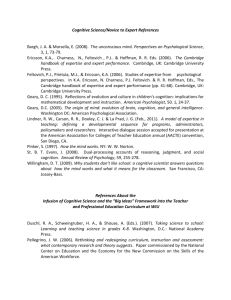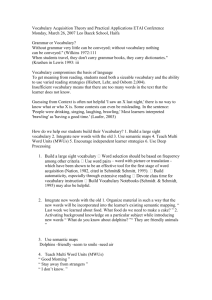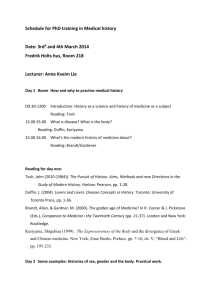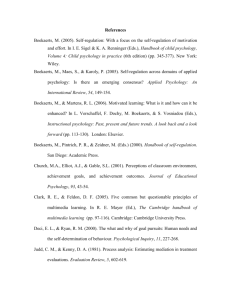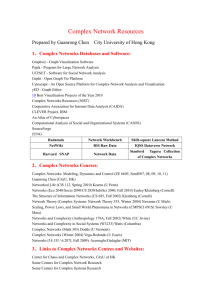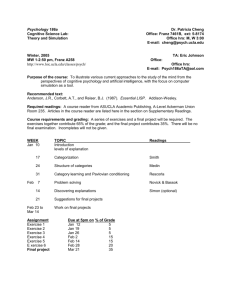doc
advertisement
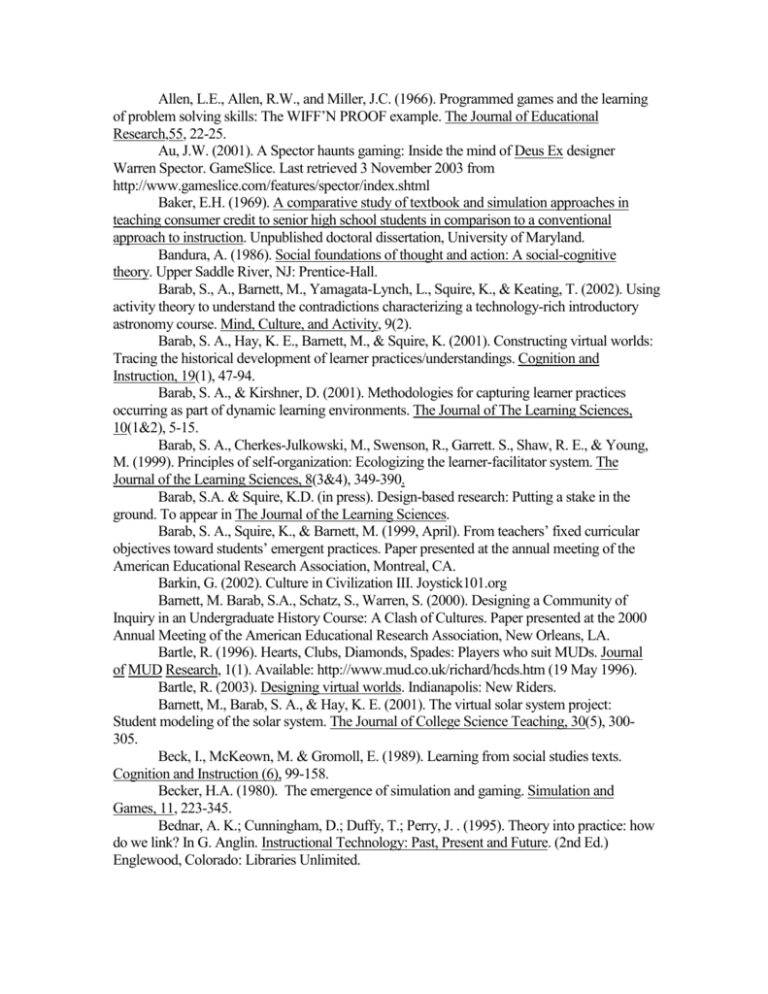
Allen, L.E., Allen, R.W., and Miller, J.C. (1966). Programmed games and the learning of problem solving skills: The WIFF’N PROOF example. The Journal of Educational Research,55, 22-25. Au, J.W. (2001). A Spector haunts gaming: Inside the mind of Deus Ex designer Warren Spector. GameSlice. Last retrieved 3 November 2003 from http://www.gameslice.com/features/spector/index.shtml Baker, E.H. (1969). A comparative study of textbook and simulation approaches in teaching consumer credit to senior high school students in comparison to a conventional approach to instruction. Unpublished doctoral dissertation, University of Maryland. Bandura, A. (1986). Social foundations of thought and action: A social-cognitive theory. Upper Saddle River, NJ: Prentice-Hall. Barab, S., A., Barnett, M., Yamagata-Lynch, L., Squire, K., & Keating, T. (2002). Using activity theory to understand the contradictions characterizing a technology-rich introductory astronomy course. Mind, Culture, and Activity, 9(2). Barab, S. A., Hay, K. E., Barnett, M., & Squire, K. (2001). Constructing virtual worlds: Tracing the historical development of learner practices/understandings. Cognition and Instruction, 19(1), 47-94. Barab, S. A., & Kirshner, D. (2001). Methodologies for capturing learner practices occurring as part of dynamic learning environments. The Journal of The Learning Sciences, 10(1&2), 5-15. Barab, S. A., Cherkes-Julkowski, M., Swenson, R., Garrett. S., Shaw, R. E., & Young, M. (1999). Principles of self-organization: Ecologizing the learner-facilitator system. The Journal of the Learning Sciences, 8(3&4), 349-390. Barab, S.A. & Squire, K.D. (in press). Design-based research: Putting a stake in the ground. To appear in The Journal of the Learning Sciences. Barab, S. A., Squire, K., & Barnett, M. (1999, April). From teachers’ fixed curricular objectives toward students’ emergent practices. Paper presented at the annual meeting of the American Educational Research Association, Montreal, CA. Barkin, G. (2002). Culture in Civilization III. Joystick101.org Barnett, M. Barab, S.A., Schatz, S., Warren, S. (2000). Designing a Community of Inquiry in an Undergraduate History Course: A Clash of Cultures. Paper presented at the 2000 Annual Meeting of the American Educational Research Association, New Orleans, LA. Bartle, R. (1996). Hearts, Clubs, Diamonds, Spades: Players who suit MUDs. Journal of MUD Research, 1(1). Available: http://www.mud.co.uk/richard/hcds.htm (19 May 1996). Bartle, R. (2003). Designing virtual worlds. Indianapolis: New Riders. Barnett, M., Barab, S. A., & Hay, K. E. (2001). The virtual solar system project: Student modeling of the solar system. The Journal of College Science Teaching, 30(5), 300305. Beck, I., McKeown, M. & Gromoll, E. (1989). Learning from social studies texts. Cognition and Instruction (6), 99-158. Becker, H.A. (1980). The emergence of simulation and gaming. Simulation and Games, 11, 223-345. Bednar, A. K.; Cunningham, D.; Duffy, T.; Perry, J. . (1995). Theory into practice: how do we link? In G. Anglin. Instructional Technology: Past, Present and Future. (2nd Ed.) Englewood, Colorado: Libraries Unlimited. Berson, M.J. (1996). Effectiveness of Computer Technology in the Social Studies: A Review of the Literature. Journal of Research on Computing in Education, 28 (4), 486-99. Blanton, W. E., Moorman, G. B., Hayes, B. A., & Warner, M. W. (1997). Effects of participation in the Fifth Dimension on far transfer. Journal of Educational Computing Research, 16, 371-396. Boocock, S.S. (1968). An experimental study of the learning effects of two games with simulated environmments. In S.S. Boocock & E.O. Schild (Eds.), Simulation games in learning. (pp. 107-133). Beverley Hills, CA: Sage. Bradshaw, L. (2002). Case Study: Sim City. Presentation made to the Markle Foundation January 31, 2002. http://www.markle.org/News/SimCity01-31-02.pps Brooker, R.G. (1988). Truth as a variable: Teaching political strategy with simulation games. Simulation & Games, 19, 43-58. Brown, A. L. (1992). Design experiments: Theoretical and methodological challenges in creating complex interventions in classroom settings. The Journal of the Learning Sciences, 2, 141-178. Brown, A.L., Campione, J.C., Webber, J.S., & McGilly, K. (1992). Assessing the thinking curriculum: New tools for educational reform. In Gifford, B.R. & O’Connor, M.C. (Eds.) Changing assessments: Alternative views of aptitude, achievement and instruction. Boston, MA: Kluwer Academic Publishers. Brown K. & Cole, M. (2002). Cultural historical activity theory and the expansion of opportunities for learning after school. http://lchc.ucsd.edu/People/MCole/browncole.html Carroll, J. M. (1998). Minimalism Beyond the Nurnberg Funnel. MIT Press: Cambridge, MA. Cassell, J. & Jenkins, H. (1998). From Barbie to Mortal Kombat : Gender and computer games. Cambridge, MA: MIT Press. Chi, M., Glaser, R., & Rees, E. (1982). Expertise in problem solving. In R. Sternberg (Ed.), Advances in the psychology of human intelligence (Vol. 1, pp. 7-75). Hillsdale, NJ: Lawrence Erlbaum. Church, D. (2000). Abdicating authorship. Presentation made at the annual meeting of the Game Developer’s Conference, San Jose, CA. March. Clark, R. E. 1983. Reconsidering research on learning from media. Review of Educational Research 53(4), 445-459. Clarke, W. (1970). A research note on simulation in the social studies. Simulation and Games, 1, 203-210 Clegg, A.A. (1991). Games and simulations in social studies education. In Shaver, J. P., (Ed). Handbook of research on social studies teaching and learning. New York: Macmillan. Pp. 523-528. Cobb, P., Stephan, M., McClain, K., & Gravemeijer, K. (2001). Participating in classroom mathematical practices. Journal for the Learning Sciences, 10(1&2), 113-164. Cobb, P., Confrey, P. diSessa, A., Lehrer, R., Schauble, L. (2003). Design experiments in educational research. Educational Researcher, 32(1), 9–13. Cognition and Technology Group at Vanderbilt, (1993). Anchored instruction and situated cognition revisted. Educational Technology, 33 (3), 52- 70. Cohen, K.C. (1970). Effects of the CONSUMER GAME on learning and attitudes of selected seventh grade students in a target –area school, Report No. 65. The center for the Study of Social Organization of Schools, Johns Hopkins University. Cole, M. (1996). Cultural psychology: A Once and future discipline. Cambridge, MA: The Harvard University Press. Cole, M. & Wertsch, J. V. Beyond the individual-social antimony in discussions of Piaget and Vygotsky. Unpublished manuscript last retrieved 3 November 2003 from: http://www.massey.ac.nz/~alock/virtual/colevyg.htm Colella, V., Klopfer, E., and Resnick, M. (2001). Adventures in Modeling: Exploring Complex, Dynamic Systems with StarLogo. New York: Teachers College Press. Collins, (1992). Toward a design science of education. In E. Scanlon & T. O’Shea (Eds.), New directions in educational technology (pp. 15–22). New York: Springer-Verlag. Collins A., Brown, J. S., and Newman, S. E.. Cognitive apprenticeship: Teaching the crafts of reading, writing, and mathematics. In L. Resnick, (Ed.) Knowing, Learning, and Instruction: Essays in Honor of Robert Glaser. Lawrence Erlbaum Associates, 1989. Collins, P., Shukla, S., Redmiles, D. (2002). Activity Theory and System Design: A View from the Trenches. Computer Supported Cooperative Work: the Journal of Collaborative Computing 11 (1-2): 55-80. Cordtz, W.W. (1969). A simulation methodology of instruction in a college course of American Studies. Unpublished doctoral dissertation, United States International Universty. Cordova, D. I., & Lepper, M. R. (1996). Intrinsic motivation and the process of learning: Beneficial effects of contextualization, personalization, and choice. Journal of Educational Psychology, 88, 715-730. Counsell, C. (2000). Historical knowledge and historical skills: A dichotomy. In J. Arthur, & R. Phillips (Eds.), Issues in History Teaching (pp. 54-71). London: Routledge. Cowley, R. (1999). What if? New York: Berkley Books. Csikszentmihalyi, M. 1990. Flow: The psychology of optical experience. New York: Harper Perennial. Cunningham, D. J. (1992). Beyond Educational Psychology: Steps Toward a Educational Semiotic. Educational Psychology Review 4, 165-194. De Carteau, M. (1984). General Introduction. The Practice of Everyday Life.Trans. Steven F. Rendail. Berkeley: University of California Press, 1984. Denzin, N.K., (1989). The research act, 3rd ed. Englewood Cliffs, NJ: Prentice Hall. Dewey, J. (1938). Logic, the theory of inquiry. New York: H. Holt and Co. Diamond, J. (1999). Guns, germs, and steel: The fates of human societies. New York: Norton. Dick, W. (1991). An instructional designer's view of constructivism. Educational Technology, 31(5), 41-44. Dooley, B.J. (1969). Research on the market game. In G. Dawson (Ed.) Economic Education experiences of enterprising teachers, Vol. 5. New York: Joint Council on Economic Education. Downey M. T. & Levstick, L. S. (1991). Teaching and learning history. In Shaver, J. P., (Ed). Handbook of research on social studies teaching and learning. New York: Macmillan pp. 400-410. Duffy, T. M., & Cunningham, D. J. (1996). Constructivism: Implications for the design and delivery of instruction. In D. Jonassen (Ed.), Handbook of research for educational communications and technology, (pp. 170-198). Washington, DC: Association for Educational Communications and Technology. Duffy, T.M. & Jonassen, D.H. (1991). Constructivism: New implications for instructional technology? Educational Technology, 31(5), 7-11. Duke, R.D. (1964). Game-simulation studies in urban land use allocation. Unpublished doctoral dissertation, University of Michigan. Dunn, R. (2000). Edmonds, B. & Hales, D. (n.d.). Computational simulation as theoretical experiment. Report published by the Centre for Policy Modelling, Aytoun Building, Manchester Metropolitan University, Manchester, UK. Retrieved on 3 November 2003 from http://cfpm.org/cpmrep106.html Ehman, L. (1980). The American school in the political socialization process. Review of Educational Research, 50(1). 99-119. Ehman, L. & Glenn, A.D. (1987). Computer-based education in the social studies. Bloomington, IN: Social studies Development Center ERIC Clearinghouse for Social Studies/ Social Science Education. Ehman, L. H. & Glenn, A. D. (1991). Interactive technologoy in social studies. In Shaver, J. P., (Ed). Handbook of research on social studies teaching and learning. New York: Macmillan.Pp 513-522. El'konin, D.B. (1971). Toward The Problem of Stages in the Mental Development of Children. Voprosy psikhologii, 1971. No. 4, 6-20; Soviet Translated: Nikolai Veresov. Online Version: Psychology and Marxism Internet Archive (marxists.org) 2000 Engeström, Y. (1987). Learning by expanding. Helsinki: Orienta-konsultit. Engestrom, Y., (1990). When is a tool? Multiple meanings of artifacts in human activity. In: Y. Engestrom, (Ed). Learning, working and imagining: Twelve studies in activity theory. Helsinki: Orienta-Konsultit Oy. 171-195. Engeström, Y. (1993). Developmental studies of work as a testbench of activity theory: The case of primary care medical practice. In S. Chaiklin & J. Lave (Eds.) Understanding practice: Perspectives on activity and context (pp. 64-103). Cambridge, MA: Cambridge University Press. Engeström, Y. (1999). Activity theory and individual and social transformation. In Y. Engeström, R. Miettinen, & R. Punamaki, (Eds.). Perspectives on activity theory (pp. 19-38). Cambridge, MA: Cambridge University Press. Feurzeig, W., and N. Roberts. (1999) Modeling and Simulation in Precollege Science and Mathematics. NY: Springer. Fletcher, J.L. (1971). The effectiveness of simulation games as learning environments: A progrposed program of research. Simulation and Games, 2, 473-488. Friedman, T. (1999). Civilization and Its Discontents: Simulation, Subjectivity, and Space. In Smith, G. (Ed.). On a Silver Platter: CD-ROMs and the Promises of a New Technology. NY: New York University Press, 1999. Frye, B. & Frager, A.M. (1996). Civilization, Colonization, SimCity: Simulations for the Social Studies Classroom. Learning and Leading with Technology, 24(2), 21-23, 32. Games-to-Teach Team. (2003). Design principles of next-generation digital gaming for education. Educational Technology, 43(5), 17-33. Gardner, H. (1991). The Unschooled mind: How children think and how schools should teach. New York: Basic Books. Garvey, D. M. & Seiler, W.H. (1966). A study of effectiveness of different methods of teaching international relations to high school students (Final report cooperative research project No. S-270). Emporia: Kansas State Teachers College. Gee, J.P. (1992). The social mind: Language, ideology, and social practice. New York: Bergin & Garvey. Gee, J. P. (2000-2001). Identity as an analytic lens for research in education. Review of Research in Education 25: 99-125. Gee, J. P. (2003). What video games have to teach us about learning. New York: Palgrave. Geertz, C. (1983). Thick description: Toward an interpretive theory of culture. In R. M. Emerson (Ed.), Contemporary field research: A collection of readings (pp. 37–59). Prospect Heights, IL:Waveland Press. Glaser, B. G., & Strauss, A. L. (1967). The discovery of grounded theory. Hawthorne, NY: Aldine. Goodlad, J. (1984). A place called school. New York: McGraw-Hill. Gredler, M.E. (1996). Educational games and simulations: A technology in search of a research paradigm. In In Jonassen, D.H. (Ed.), Handbook of research for educational communications and technology, p. 521-539. New York: MacMillan. Greene, S. (1994). The problems of learning to think like a historian: Writing history in the culture of the classroom. Educational Psychologist, 29(2), 89-96. Grossman, 2000. Testimony before the United States Senate Commerce Committee, March 21, 2000. Guba, E. G., & Lincoln, Y. S. (1983). Epistemological and methodological bases of naturalistic inquiry. In G. F. Madaus, M. S. Scriven., and D. L. Stufflebeam (Eds.), Evaluation models: Viewpoints on educational and human services evaluation (pp. 311-334). Boston, MA: Kluwer-Nijhoff Publishing. Guberman, S. R., & Saxe, G. B. (2000). "Mathematical problems and goals in children’s play of an educational game." Mind, Culture, and Activity, 7, 201-216. Guy, E. S. 2003 Patterns as Artifacts for User-Developer Collaborative Design. ECSCW 2003 Workshop W1: Applying Activity Theory to CSCW Research and Practice. 8th European Conference on Computer Supported Cooperative Design, Helsinki, Finland, September 14-91, 2003. http://www.uku.fi/atkk/actad/ecscw2003-at/guy.pdf Hakkarainen, P. 1999. Play and Motivation in Engström, Y. Miettinen, R. & Punamäki, R-L (eds.). Aspects on Activity Theory. Cambridge University Press. Heinich, R., Molenda, M., Russell, J.D., & Smaldino, S.E. (1996). Instructional media and technologies for learning (6th ed.). Upper Saddle River, NJ: Merrill. Herz, J.C. (1997). Joystick Nation. How videogames ate our quarters, won our hearts, and rewired our minds. Princeton, NJ: Little Brown & Company. Hetzner, D.R. (1972). Life decisions: A computer-based simulation game for social studies classrooms (Doctoral dissertation, State University of New York at Buffalo). Dissertation Abstracts International, 33, 1078A. Holland, W., Jenkins, H., & Squire, K. (2003). Theory by design. In Wolf, M.J. P. & Perron, B. (Eds.) The video game theory reader. New York: Routledge. * Hope, W. C. (1996). It's Time to Transform Social Studies Teaching. Social Studies, 87(4).149-151. Hutchins, E. (1995). Cognition in the Wild. MIT Press, Cambridge, MA. Jenkins, H. (in press). Games, the new lively art. In Goldstein, J. & Raessens, J. (Eds.) Handbook of Computer Game Studies (Cambridge: MIT Press, Forthcoming). Jenkins, H. Squire, K. & Tan, P. (in press). You can’t bring that game to school! Design of Supecharged. To appear in Laurel, B. (Ed.) Design research. Cambridge, MA: MIT Press. Johnson, S. (2002). Emergence: The connected lives of ants, brains, cities and software. New York: Touchstone Books. Johnson, R.T., Johnson, D.W., & Stanne, M.B. (1985). The effects of cooperative, competitive, and individualistic goal structures. On computer-assisted instruction. Unpublished manuscript, University of Minnesota. Kim, A. J., Koster, R. & Vogel, R. (2001). Community Design for Large-Scale Gaming Worlds. Workshop presented at the Game Developer’s Conference, San Jose, CA:, March. King & Borland, Dungeons and Dreamers: The Rise of Computer Game Culture from Geek to Chic. Klopfer, E. & Squire, K. (2003). Collaboration in Augmented Worlds. Proceedings of the Computer Supported Collaborative Learning Conference, June, Norway. Kolson, K. (1994). The Politics of City Planning Simulations. Paper presented at the Annual Meeting of the American Political Science Association, New York, NY, September 14, 1994. Lakoff, G. & Johnson, M. (1980). Metaphors we live by. Chicago: Chicago University Press. Laurel, B. (2002). Utopian entrepreneur. Cambridge, MA: MIT Press. Lave, J., & Wenger, E. (1991). Situated learning: Legitimate peripheral participation. New York: Cambridge University Press. Lee, J.L. (1994). Effectiveness of the Use of Simulations in a Social Studies Classroom. ERIC Documents. Leont’ev, A. (1981). Problems of the development of mind. Moscow: Progress. Leont’ev, A. (1989). The problem of activity in the history of Soviet psychology. Soviet Psychology, 27(1), 22–39. Lepper, M. R., Greene, D., & Nisbett, R. E. (1973). Undermining children's intrinsic interest with extrinsic reward: A test of the "overjustification" hypothesis. Journal of Personality and Social Psychology, 28, 129-137. Levstik, L. S., & Barton, K. C. (1997). Doing history: Investigating with children in elementary and middle schools. Mahwah, NJ: Lawrence Erlbaum. Lincoln, Y. S., & Guba, E. G. (1985). Naturalistic inquiry. Beverly Hills, CA: SAGE. Livingston, S.A. (1970a). Simulation games as advanced organizers in the learning of social science materials (Report No. 64). The Center for the Study of Social Organization of Schools, Johns Hopkins University. Livingston, S.A. (1970b). Simulation games and attitude changes: Attitudes toward the poor (Report No. 63). The Center for the Study of Social Organization of Schools, Johns Hopkins University. Livingston S. A. & Stoll, C.S. (1973). Simulation games: an introduction for the social studies teacher. New York: Free Press. Lloyd, J.W. (1970). Role playing, collective bargaining and the measurement of attitude change. The Journal of Economic Education (1), 104-110. Loewen, J. W. (1995). Lies my teacher told me: Everything your American history textbook got wrong. New York: Simon & Schuster. Mabry, L. (1999). Portfolio plus: A critical guide to alternative assessment. Thousand Oaks, CA: Sage. Malone, T. W. (1981). Toward a theory of intrinsically motivating instruction. Cognitive Science, (4), 333-369. Malone, T. W., & Lepper, M. R. (1987). Making learning fun: A taxonomic model of intrinsic motivations for learning. In R. E. Snow & M. J. Farr (Eds.), Aptitude, learning, and instruction: III. Conative and affective process analysis (pp. 223-253). Hillsdale, NJ: Erlbaum. Mayer, R. E., Quilici, J. H., Moreno, R., Duran, R., Woodbridge, S., & Simon, R. (1997). Cognitive consequences of participation in a Fifth Dimension after-school computer club. Journal of Educational Computing Research, 16, 353-370. McLaren, P. (1994). Life in schools: An introduction to critical pedagogy. White Plains, NY: Longman Publishing. Media-X. website? Press release/ Messick, S. (1989). Validity. In Linn, R. L., (Ed.) Educational measurement (3rd Ed. pp. 13-103). New York: American Council on Education, MacMillan. Mitchell, E. (1985). The dynamics of family interaction around home video games. Special Issue: Personal computers and the family. Marriage and Family Review 8(1-2), 121)135. Monroe, M. W. (1968). Games as teaching tools: An examination of the COMMUNITY LAND USE GAME. Unpublished master’s thesis, Cornell University. Murray, J. H. (1997). Hamlet on the Holodeck: The Future of Narrative in Cyperspace. New York: The Free Press. Nicolopoulou, A., & Cole, M. (1993), Generation and transmission of shared knowledge in the culture of collaborative learning: The Fifth Dimension, its play-world, and its institutional contexts. In E. Forman, N. Minick, & C. Stone (Eds.), Contexts for learning (pp. 283-314). New York: Oxford. Patterson, J. H. & Smith, M.S. (1986). The role of computers in higher order thinking. In J.A. Culbertson & L.L. Cunningham (Eds.), Microcomputers in education. 85th Yearbook fo the National Society for the Study of Education (Part I, ,pp. 81-108). Chicago: University of Chicago Press. Pellegrini, A. D. (Ed.). (1995). The future of play theory: A multidisciplinary inquiry into the contributions of Brian Sutton-Smith. Albany, NY: State University of New York Press. Peirce, C.S. (1877/1986). The Fixation of Belief. In N. Houser & C. Kloesel (Eds.) The Essential Peirce (Vol 1, pp. 186-1999). Bloomington, IN: Indiana University Press. Peirce, C.S. (1878/1986). Deduction, induction, and hypothesis. In N. Houser & C. Kloesel (Eds.) The Essential Peirce (Vol 1, pp. 109-122). Bloomington, IN: Indiana University Press. Peirce, C.S. (1897/1985). Logic as Semoitic: The theory of signs. In Innis, R.E (Ed.), Semiotics, Bloomington, IN: Indiana University Press. Perkins, D.N. (1992). Smart schools: Better thinking and learning for every child. New York: Free Press. Poole, Steven (2000) Trigger Happy: Videogames and the entertainment revolution. London: 4th Estate. Prensky, M. (2001). Digital Game-Based Learning. New York: McGraw Hill. Provenzo, E.F. (1991). Video kids: Making sense of Nintendo. Cambridge, MA: Harvard. Reiber, L. (1996). Seriously considering play: Designing interactive learning environments based on the blending of microworlds, simulations, and games. Education and Training Resource & Development, 44, 42-58. Reigeluth, C.M. (1999). Instructional-design theories and models, Vol. 2. Mahwah, NJ: Erlbaum. Resnick, L.B. (1987). Learning in school and out. Educational Researcher, 16(9), 1320. Resnick, M. (1994). Turtles, Termites, and Traffic Jams: Explorations in Massively Parallel Microworlds. Cambridge, MA: MIT Press. Roughgarden, J., Bergman, A., Shafir, S., & Taylor, C. (1996). Adaptive Computation in Ecology and Evolution: A Guide for Future Research. In R. Belew & M. Mitchell (Eds.), Adaptive Individuals in Evolving Populations: Models and Algorithms (Vol. Proceedings Volume XXVI Santa Fe Institute Studies in the Science of Complexity, pp. 25-30). Reading, MA: Addison-Wesley. Salomon, G. (Ed.). (1993). Distributed cognitions: Psychological and educational considerations. New York: Cambridge University Press. Salen, K. & Zimmerman, E. (2003). Rules of play: Game design fundamentals. Cambridge, MA: MIT Press. Savery, J. R., and Duffy, T. M. (1995). Problem based learning: An instructional model and its constructivist framework. Educational Technology, 35, 31-38. Schank, R. (1994). The Design of Goal-Based Scenarios. Journal of The Learning Sciences, 3(4), 303-304. Scollen ,R & S (1981). Narrative, Literacy and Face in Interethnic Communication, Ablex. Schwartz, D. L., Lin, X., Brophy, S., & Bransford, J. D. (1999). Towards the development of flexibly adaptive instructional design. In C. M. Reigeluth (Ed.), InstructionalDesign Theories and Models: A New Paradigm of Instructional Theory (Vol. 2, pp. 183-213). Mahwah, NJ: Erlbaum. Siexas, P. (2000). Schweigen! die Kinder! Or, Does postmodern history have a place in the schools? In Stearns, P.N. Seixas, P., & Wineburg, S. (Eds.), Knowing teaching & learning history: National and international Perspectives. New York: New York University Press. Silverman, D. (1993). Interpreting qualitative data: Methods for analysing talk, text, and interaction. Newbury Park, CA: SAGE. Spring, J. (1991). American education: An introduction to social and political aspects, 5th Ed. White Plains, NY: Longman Publishing. Squire, K. (2002). Cultural Framing of Computer/Video Games, Game Studies: The International Journal of computer Game Research 1(2). http://www.gamestudies.org/0102/squire/ Squire, K. (2003). Video games in education. International Journal of Intelligent Games & Simulation, 2(1). Last retrieved November 1, 2003: http://www.scit.wlv.ac.uk/~cm1822/ijkurt.pdf Squire, K.D., Makinster, J., Barnett, M., Barab, A.L., & Barab, S.A. (2003). Designed Curriculum and Local Culture: Acknowledging the Primacy of Classroom Culture. Science Education. 87:1– 22 Squire, K. & Jenkins, H. (2002). The art of contested spaces. In Game on!, King, L. (Ed.) London, England: Barbican. Stadskley, R. (1969). A comparative study of simulation gaming and lecture-discussion method. Unpublished Master’s Thesis, University of Minnesota. Stake, R. E. (1995). The art of case study research. Thousand Oaks, CA: SAGE Publications. Stake, R.E. (2004). Standards-based and responsive evaluation. Thousand Oaks, CA: Sage. Starr, P. (1994). Seductions of sim, The American Prospect 5(17). Stearns, P.N. Seixas, P., & Wineburg, S. (2000). Knowing teaching & learning history: National and international perspectives. New York: New York University Press. Stipek, D.J. (1993). Motivation to Learn: From Theory to Practice, 3ed. (Chapter 4Social Cognitive Theory, pp.43-58). Boston: Allyn&Bacon Sutton-Smith, B. (1979). Play and learning. New York: Gardner Press. Teauge, M. & Teague, G. (1995). Learning and Leading with Technology, 23 (1) 2022. Thiagarajan, S. (1998). The Myths and Realities of Simulations in Performance Technology. Educational Technology, 35-41. Page: 9 Turkle, S. (1995). Life on the screen: Identity in the age of the internet. New York: Touchstone. Turkle, S. (1997). "Seeing Through Computers," The American Prospect (8) 31 Turkle, S. (2003). Turner, Victor. "Liminality and communitas." The ritual process: Structure and antistructure. Chicago: Aldine, 1969, pp. 94-113. Vansledright, B. A. (1997/98). On the importance of historical positionality to thinking about and teaching history. The International Journal of Social Education, 12(2), 1-18. Vincent, B. (1986). Design for decision-making in the classroom. T.H.E. Journal, 14, 80-84. Vygotsky, L (1978). Mind and Society. Cambridge, MA: MIT Press. Vygotsky, L. S. (1981). The development of higher forms of attention in childhood. In J. V. Wertsch (Ed.), The concept of activity in Soviet psychology. Armonk, N.Y.: Sharpe. Vygotsky, L.S. (1982) Sobranie sochinenii, Tom pervyi: Voprosy teorii i istorii psikhologii [Collected works, vol.I: Problems in the theory and history of psychology]. Moscow: Izdatel'stvo Pedagogika. Wartofsky, M. (1973). Models. Dordrecht: D. Riedel. Weiner, B. (1986). An attributional theory of motivation and emotion. New York: Springer-Verlag. Wenger, E. (1998). Communities of practice: Learning, meaning, and identity. Cambridge, MA: Cambridge University Press. Wentworth, D.R. (1972). The effectiveness of a learning game for teaching introductory economics in selected two-year colleges. Unpublished doctoral dissertation, University of Minessorta. Wentworth, D.R. & Lewis, D.R. (1973). A review of research on instructional games and simulations in social studies education. Social Education. P. 432-440. Wertsch, J. (1998). Mind as action. New York: Oxford University Press. Wertsch, J. (2000). Can we teach knowledge and belief at the same time?. . In Stearns, P.N. Seixas, P., & Wineburg, S. (Eds.), Knowing teaching & learning history: National and international Perspectives., pp. 38-50. New York: New York University Press. White, B.Y. & Frederickson, J.R. (1998). Inquiry, modeling, and metacognition: Making science accessible to all students. Cognition and Instruction, 16(1), 3-118. Whitson, J.A. (1997). Cognition as semiosic process: From situated mediaton to critical reflective transcendence. In Kirshner, D. & Whitson, J. A. (Eds.) Situated Cognition: Social, Semiotic, and Psychological Perspectives, pp. 97-150. Mahwah, NJ: Lawrence Erlbaum Associates. Wineburg, S. (1992). "Probing the Depths of Students' Historical Knowledge." Perspectives: Newsletter of the American Historical Association 30, 20-24. Wineburg, S. (1999). Reading Abraham Lincoln: An expert / expert study in the interpretation of historical texts,” Cognitive Science (22) 319-346. Wineburg, S. (2000). Making historical sense. In Stearns, P.N. Seixas, P., & Wineburg, S. (Eds.), Knowing teaching & learning history: National and international Perspectives., pp. 306-326. New York: New York University Press. Wineburg, S. (2001). Historical thinking and other unnatural acts: Charting the future of teaching the past. Philadelphia: Temple University Press. Wing, R. L. (1966). Two computer-based economics games for sixth graders. The American Behavioral Scientist (10), 31-33. Wolfram, S. (2002). A New Kind of Science. Champaign, IL: Wolfram Media, pp. 573 and 1072-1073, 2002. Wright, W. (2001). Design Plunder. Keynote at the 2001 Gaming Developer’s Conference, San Jose, CA. Young, B. M., (2001). Doom as life in the rat race. Article posted at joystick101.org. Last retrieved November 3, 2003 from http://www.joystick101.org/story/2001/10/2/85544/4214
